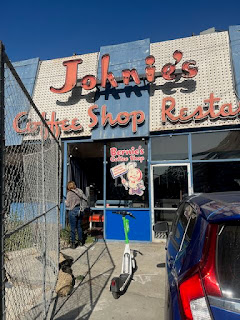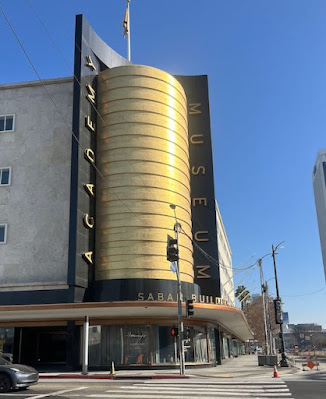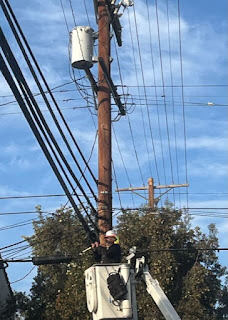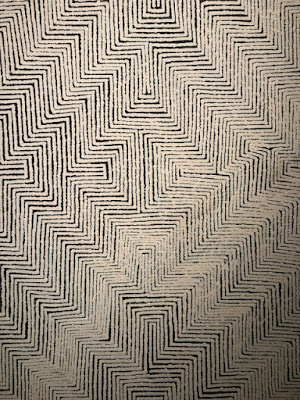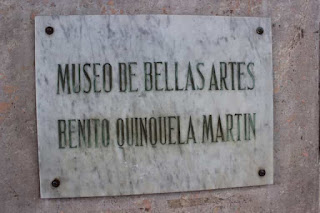Our grand parenting duties shrink back as our granddaughter gets older and has more autonomy and more activities to fill up her time. That's not a bad thing. We still get to spend lots of time with our daughter and granddaughter, but I also have plenty of time to read, think, write, and delete emails that never seem to slow down. Even as I unsubscribe to emailers I never subscribed to, new ones seem to find me.

But we had an anniversary yesterday and we decided to take the ferry and wander around downtown Seattle.
It's been pretty rainy, but the sun made itself known as we approached the ferry terminal.
We tried the post office on 1st Street, but it was closed for lunch.
So we made our way to Pike Place Market for some clam chowder. The seats weren't that comfy, but the chowder was hot and the guy with the red sleeves kept up a constant entertaining chatter.
We wandered a bit through the market. Then across the street to a kitchen ware shop where we found a gift for our granddaughter and her dad. We stopped in at
H-Market for a look around. Then made it to another post office where I was able to send my package. I had the book in an envelope I'd received a different book in, but the clerk immediately told me I should buy a new envelope which would be cheaper than buying a roll of tape for the envelope. While we waited, another customer asked another clerk if he could tape the address label on and was told to buy a roll of tape ($3.99). This is new. Post office personnel used to be helpful. I guess Trump's postmaster who's apparently still in charge, thinks saving pennies is better than making customers feel like coming back.
Then to the
Seattle Art Museum. I'm always taken aback by how much it costs to enter major museums these days. I know it costs money to run things, but art is a major expression of a culture and museums are a serious part of public education. If we can pay to be the most armed country in the world, we ought to pay even a percent of that for public art museums. But I quickly got over that as we interacted with what was on the walls, the floors, and even the ceiling in places.
There's clearly a change in how museums display items. There's a lot of obviously intentional diversity. There's mixing up of pieces of different eras and cultures to find (or at least claim to find) commonalities.

And I was particularly struck by the universality of human art - both geographically and in terms of time. We tend to think that we are smarter and more skilled than people who lived hundreds or thousands of years ago. Certainly a fair chunk of today's US population (like those who believe their cult leader is going to improve their lives) aren't nearly as wise as the brightest people in past generations.
On the left is Charles d'Amboise. The painting was done about 1505 (just over 500 years ago) by Bernardine de'Conti who lived in Milan about 1470 -1522.
The description says:
"The French nobleman Charles d'Amboise became the governor of the Duchy of Milan after it was conquered by France. The collar of scallop shells and knots denotes the Order of SaintMichael, granted to him about 1505, perhaps the occasion for commissioning this portrait.
D'Amboise was a friend and patron of Leonardo da Vinci, but he hired a more conservative artist for his portrait and chose to be portrayed in a classic profile view, which records his features but provides no psychological insight. He most likely wanted to link his image with the great rulers of the ancient past, depicted in side views on coins and medals like those shown in the case nearby D'Ambroise himself was an avid coin collector as he proudly demonstrates here."
I'm going to assume the curator knows a lot more than I do about art and this painting. But I'm not sure why a side view can't provide psychological insight, or that a full face portrait can. But what little we learn tells us a great deal. With a different haircut, or maybe just a baseball cap, he could fit in walking down the street today. There was a hierarchy of which he was in an upper level, and he collected coins. And the painter could easily get work in today's world. Both could probably fit into 2024 fairly easily with a little bit of coaching on the advances of science.
The one on the right is not as old (about 1699), painted by French artist Nicolas Colombel who lived from 1644-1717. He died fifteen years before George Washington was born. He was a year younger than Isaac Newton, but died ten years before Newton. Nevertheless, the story of Cupid (Eros) and Psyche is much older.
Wikipedia tells us:"Eros and Psyche appear in Greek art as early as the 4th century BC"
The curator wrote the following to accompany this painting:
"The jealous goddess Venus sent her son Cupid to make Psyche fall in love with a horrible monster. Instead, Cupid became enamored himself and installed Psyche in a palace where he visited her at night so that she couldn't learn his identity. One night she stole a peek at his beautiful face. Startled awake, Cupid left immediately, and his palace vanished. Psyche wandered the earth search for her lover, performing impossible tasks set by Venus in hopes of winning him back. Finally, Jupiter intervened: he made Psyche a goddess and reunited her with Cupid, giving their story a happy ending. Here Cupid has just abandoned Psyche, who chases him as he hovers out of reach. This moment allows Colombel, a French artist who was trained in Rome, to show the Roman countryside - the appropriate setting for this classical myth."
So this story goes back 2500 years, yet we have the same human emotions and conflicts: a woman possibly falling in love with a monster (how many battered wives are there today?); a forbidden young love; a jealous and vengeful mother-in-law (no they aren't married, but Venus was Cupid's mother). I'm not sure why the curator thinks the Roman woods to be the appropriate background, perhaps because the Romans appropriated much of Greek culture including their myths.
I knew from the beginning this post was going to be much too long, so let me jump to another exhibit - this of Ausralian aboriginal artists.
These large detailed paintings speak to me in a language I can't identify. They tell stories of people and worlds I do not know. Yet they move me a great deal. This is a beauty and a visual language that still exists, outside of Western culture.

Here's detail of a painting called Kalipinypa Rockhole (2003) painted by Elizabeth Marks Nakamara. The curator writes:
"Lightning bolts that ignite the sky are the source for this striking white maze. Kalipinypa is an important site where ancestral forces swept in with a huge storm that caused lightning to flash and water to rush across the country. They left behind a rock hole surrounded with sandhills that are seen here as vibrant patterns created by dotting that fuses into lines that wiggle ever so slightly. Elizabeth Marks Nakamara was married to the renowned artist Mick Namarari. She watched his painting for years but did not begin to paint herself until after his death in 1998."
One more from that collection. There's no story with the description - just the facts:
" Marapinti, 2016
Acrylic on canvas
Nanyuma Napangati
Australian Aboriginal, Pintupi people,
Papunya, Western Desert, Northern Territory,
born 1940"
Most of what I know about Australian Aboriginal culture comes from Bruce Chatwin's book
Songlines, which I wrote about here. And
songlines (check the link, really!) are clearly part of this art. Truly a book worth reading.
Another descriptor at this exhibit read:
"'Dreaming is an all-embracing concept that provides rules for living, a moral code, as well as rules for interacting withthenatural environment' - Jeannie Herbert Nungwarrayi(Walpiri speaker) 2000
Dreaming is known by Pintupi speakers as Tjukurrpa. Tjukurrpa is called a template for a dynamic duty or way of observing laws passed down by ancestors - the powerful shape-shifting creators who formulated the earth's features, people, and culture. Dreamings stimulate intellectual and emotional life, as people recall extensive genealogies and ceremonial song cycles that describe the ancestors' adventures. No country - the lands, waters, flora, and fauna of an area - is without a trail of their presence, which offers a living continuum of wisdom for all to learn from.
Dotting was a biodegradable at for for centuries - on ceremonial objects, in sand paintings, and on painted and adorned bodies. Dots of ochres, down, feathers, and leaves could at times totally overcome a human form, enabling dancers to enter a mythic envelope as they enacted ceremonies. Dots began appearing in painting as a echo of this sacred significance. Some contend they help conceal sacred knowledge, and others suggest they express the flash of ancestral power.'
Surely, there's nothing here more supernatural than believers of Western religions embrace.
There was so much more reshaping edges of my brain and heart. The ways of human beings haven't really changed all that much since homo sapiens appeared. When politicians call for STEM education that leaves out art and music and humanities, we leave students with a huge hole. Science has given us a way to tinker with nature, but without a study of the human spirit and behavior and morality, we leave out the part that helps us make decisions about what technology is worth pursuing and what is likely to give us more pain than joy.
We are reminded about this daily - from the movie
Oppenheimer, to politicians' inability to pass gun reform that would significantly reduce the loss of life, to the onset of AI as a profit making venture that has the possibility of eliminating people's ability to discern truth.
 The Galata Tower is a major landmark in Istanbul. This first picture is from the Istanbul Modern (the modern art museum.). The tower is the one on the left. The other one is a minaret from a mosque.
The Galata Tower is a major landmark in Istanbul. This first picture is from the Istanbul Modern (the modern art museum.). The tower is the one on the left. The other one is a minaret from a mosque. 









 We went to the LA County Museum of Art on Thursday. And passed this bit of graffiti on the way. We also passed an Indian grocery store.
We went to the LA County Museum of Art on Thursday. And passed this bit of graffiti on the way. We also passed an Indian grocery store. 
